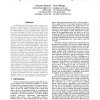Free Online Productivity Tools
i2Speak
i2Symbol
i2OCR
iTex2Img
iWeb2Print
iWeb2Shot
i2Type
iPdf2Split
iPdf2Merge
i2Bopomofo
i2Arabic
i2Style
i2Image
i2PDF
iLatex2Rtf
Sci2ools
OSDI
2002
ACM
2002
ACM
Vertigo: Automatic Performance-Setting for Linux
Combining high performance with low power consumption is becoming one of the primary objectives of processor designs. Instead of relying just on sleep mode for conserving power, an increasing number of processors take advantage of the fact that reducing the clock frequency and corresponding operating voltage of the CPU can yield quadratic decrease in energy use. However, performance reduction can only be beneficial if it is done transparently, without causing the software to miss its deadlines. In this paper, we describe the implementation and performance-setting algorithms used in Vertigo, our power management extensions for Linux. Vertigo makes its decisions automatically, without any application-specific involvement. We describe how a hierarchy of performance-setting algorithms, each specialized for different workload characteristics, can be used for controlling the processor's performance. The algorithms operate independently from one another and can be dynamically configured...
Low Power Consumption | Operating System | OSDI 2002 | Power Management Extensions | Significant Power Savings |
| Added | 03 Dec 2009 |
| Updated | 03 Dec 2009 |
| Type | Conference |
| Year | 2002 |
| Where | OSDI |
| Authors | Krisztián Flautner, Trevor N. Mudge |
Comments (0)

